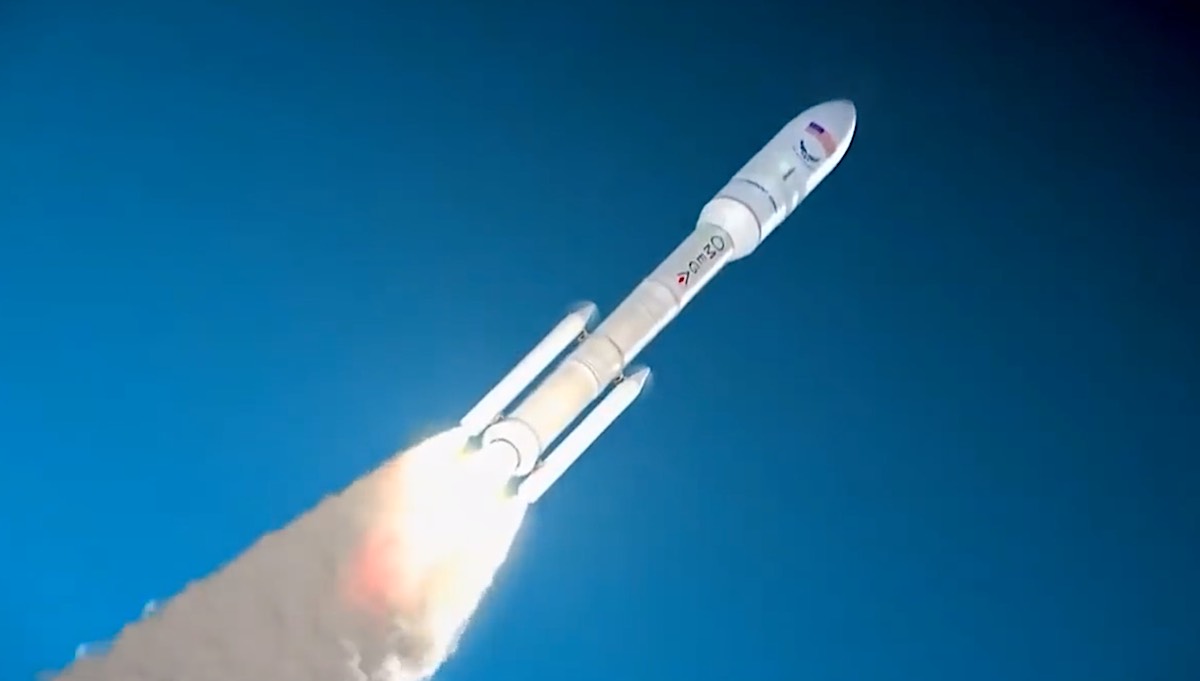
Northrop Grumman says it will not continue development of the OmegA rocket after the U.S. Space Force last month picked United Launch Alliance and SpaceX as the military’s two top launch contractors over the next seven years.
A company spokesperson said Sept. 9 that Northrop Grumman is not protesting the Space Force’s decision in the National Security Space Launch competition.
“We have chosen not to continue development of the OmegA launch system at this time,” Northrop Grumman said. “We look forward to continuing to play a key role in National Security Space Launch missions and leveraging our OmegA investments in other activities across our business.”
Northrop Grumman proposed the OmegA launch system to the Pentagon in a competition for lucrative contracts to haul national security satellites into orbit. Blue Origin, SpaceX, and United Launch Alliance were the other competitors.
The Pentagon awarded Northrop Grumman a $792 million contract in 2018 to continue development of the OmegA rocket, on top of an investment of more than $300 million in the program by Northrop Grumman and the Air Force in preceding years.
The 2018 contract was an intermediate step in the Pentagon’s effort to foster new domestic launch systems for national security satellites. The initiative was aimed at transitioning military satellite launches off of rockets using Russian-made RD-180 engines, and onto vehicles with U.S.-built engines.
ULA’s Atlas 5 rocket has launched more national security satellites than any other rocket currently in service, and its first stage is powered by the RD-180 engine.
SpaceX’s Falcon and Falcon Heavy rockets use U.S.-built engines, and ULA’s next-generation Vulcan Centaur rocket will be powered by two BE-4 main engines made by Blue Origin. Blue Origin also proposed its own New Glenn rocket — with seven BE-4 booster engines — to the Pentagon.
Northrop Grumman’s OmegA rocket was the only competitor proposing to use a solid-fueled booster. The OmegA design consisted of solid-fueled first and second stage motors produced by Northrop Grumman, with an upper stage powered by hydrogen-fueled RL10 engines built by Aerojet Rocketdyne. Strap-on solid rocket boosters would have been added to lift heavier cargo into orbit.
Officials planned to launch the OmegA rocket from pad 39B at NASA’s Kennedy Space Center in Florida.
In the end, the Space Force went with ULA and SpaceX — its two incumbent launch contractors — to continue on as launch providers for so-called “Phase 2” national security missions through 2027.
ULA, the 50-50 joint venture formed in 2006 by Boeing and Lockheed Martin, will get 60 percent of the military’s most critical satellite launch contracts awarded through late 2024 for missions that will take off between 2022 and late 2027, military officials announced Aug. 7. SpaceX will receive 40 percent of the national security launch contracts over the same period, the Pentagon said.

Will Roper, assistant secretary of the U.S. Air Force for acquisition, technology and logistics, said Aug. 7 that the military plans to wind down rocket development contracts with Northrop Grumman and Blue Origin.
Blue Origin said it will continue developing its huge privately-funded New Glenn rocket, financed by Amazon billionaire Jeff Bezos. But Northrop Grumman’s OmegA rocket was left without an anchor customer, and the publicly-traded company decided to terminate the program.
Northrop Grumman designed the OmegA launch vehicle to be profitable with just a handful of launches per year, with an emphasis on capabilities aimed at the U.S. military’s requirements.
In recent months, construction crews started assembling a tower on a mobile launch platform for the OmegA rocket at the Kennedy Space Center. Charlie Precourt, vice president of propulsion systems at Northrop Grumman, said in an interview in June that qualification test-firings of the OmegA rocket’s solid-fueled stages were completed, and engineers were gearing up for a test-firing of the launcher’s hydrogen-fueled upper stage before the end of this year.
Precourt said in June that the OmegA rocket was on schedule to be ready for its first test launch from pad 39B at the Kennedy Space Center in mid-2021. But that assumed Northrop Grumman would win a Phase 2 award from the Pentagon.
The mobile launch platform being modified for the OmegA rocket was originally used for launches of NASA’s of Apollo missions, including the Apollo 11 lunar landing flight. It was later outfitted for space shuttle launches, and was the platform from which the final shuttle flight took off 2011.
The umbilical tower being built on the platform, which was provided to Northrop Grumman through an agreement with NASA, will be disassembled at the Kennedy Space Center over the coming months. Northrop Grumman will also clear OmegA equipment from a high bay inside KSC’s cavernous Vehicle Assembly Building that would have been used to stack OmegA rocket stages.
With the OmegA program canceled, pad 39B at Kennedy will be solely used by NASA’s Space Launch System heavy-lift rocket, at least for the foreseeable future. The SLS is scheduled for its first test launch in late 2021.

In a press conference Sept. 2 after a test-firing of a SLS solid rocket booster, Precourt declined to discuss the future of the OmegA program.
But he said Northrop Grumman will “leverage” advancements made during the OmegA rocket’s development in future SLS booster designs.
The OmegA rocket was being developed at the same Northrop Grumman facility in Utah that is home to SLS booster fabrication, along with production of solid rocket motors for ULA’s Vulcan rocket and the military’s nuclear missile arsenal.
Precourt identified manufacturing efficiencies using robotic tools as an example of process improvements introduced on the OmegA program.
“We’ve leveraging OmegA in this program already,” Precourt said, referring to the Space Launch System. “It’s going to be leveraged in a number of other programs.”
Tiller agreed, adding that manufacturing techniques pioneered by the OmegA program will be repurposed for future upgrades to SLS boosters.
“From our standpoint, the OmegA work was extremely beneficial to us,” he said.
Email the author.
Follow Stephen Clark on Twitter: @StephenClark1.



